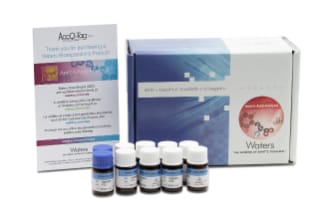
Amino acid cell culture standard kit contains 26 amino acids monitored in cell culture media or other matrices. The standard is designed for both ID and quantitative amino acid analysis.
The cell culture standard kit contains 2 vials of 17-hydrolysate standard and 8 vials of cell culture standard.
17- hydrolysate standard vial contains 17 amino acids including Alanine, Arginine, Aspartic acid, Cystine, Glutamic Acid, Glycine, Histidine, Isoleucine, Leucine, Lysine, Methionine, Phenylalanine, Proline, Serine, Threonine, Tyrosine, and Valine. The standard is lyophilized pre-weighed powder. When reconstituted in 1.2 mL of 0.1M HCl, each amino acid has a concentration of 1.00 μmol/mL except cystine which has a concentration of 0.50 μmol/mL.
Cell culture standard vial contains additional 9 amino acids including Taurine, HydroxyProline, Asparagine, Glutamine, GABA (γ-Aminobutyric acid), Tryptophan, Ornithine, AABA (α-Aminobutyric acid), and HydroxyLysine. The standard is lyophilized pre-weighed powder. When reconstituted in 250 uL of 0.1M HCl, each amino acid has a concentration of 1.00 μmol/mL.
Detailed instructions on how to prepare amino acid standards can be found in Care and Use manual (720006663EN) at www.waters.com/AAA.
|
Separation Mode |
Reversed Phase |
|
Detection Method |
UV |
|
Formulation |
Solid |
|
Storage Condition |
-20C (Freezer) |
|
System Type |
LC |
|
Quantitative |
Yes |
|
Shipping Condition |
Ambient |
|
Type |
Reference |
|
UNSPSC |
41116107 |
|
Application |
Amino Acid |
|
Brand |
AccQ-Tag Ultra |
|
Product Type |
Standard Kits |
|
Units per Package |
1 pk |
Amino Acid Cell Culture Standard Kit
The 26 amino acids in the amino acid cell culture standard kit have been tested in matrices or fluids used for cell culture. The standard is developed for quantitative amino acid analysis as well as identification. Two vials of the 17-hydrolysate standard and eight vials of the cell culture standard are included in the cell culture standard kit.
Among the 17 amino acids included in the 17-hydrolysate standard vial are Alanine, Arginine, Aspartic Acid, Cystine, Glutamic Acid, Glycine, Histidine, Isoleucine, Leucine, Lysine, Methionine, Phenylalanine, Proline, Serine, Threonine, Tyrosine, and Valine. The norm is pre-weighed lyophilized powder. Each amino acid has a concentration of 1.00 μmol/mL when reconstituted in 1.2 mL of 0.1M HCl, with the exception of cysteine, which has a concentration of 0.50 μmol/mL.
By choosing our tools, software, chemistries, and services, you have all the resources you require to complete any analysis successfully. For consistent, optimal performance of your Waters systems, only Waters Quality Components have been evaluated and verified, making them compatible with your Waters instruments to the fullest extent.
Another nine amino acids are included in the cell culture standard vial, including taurine, hydroxyproline, asparagine, glutamine, GABA (gamma-aminobutyric acid), tryptophan, ornithine, and hydroxylysine. The norm is pre-weighed lyophilized powder. Each amino acid has an amount of 1.00 μmol/mL when reconstituted in 250 uL of 0.1M HCl.
All Waters equipment is made to the highest standards in exacting and controlled conditions to guarantee that you only get the best items. You can shop for lab equipment directly from us via our online store or catalog. You can get in touch with a member of our team through either channel if you have any queries or worries about our products.
We advise to review the AccQ•Tag Ultra C18, 1.7 µm, 2.1 x 100 mm Column, 1/pK; The reversed-phase separation of amino acids derivatized with the AccQ•Tag Ultra reagent is the sole purpose of the AccQ•Tag Ultra Columns. For your most demanding amino acid analysis, each column is QA verified using the Waters Amino Acid standard to ensure repeatable performance. The Waters amino acid total system solution uses the 1.7 µm, 2.1 x 100 mm AccQ•Tag Ultra Column.
What Are Quaternary Amines and How Do They Function?
A quaternary amine is an amine salt with four groups connected to a nitrogen atom and a positive charge. The majority of microbes' negatively charged surfaces are easily attached to by cationic surfactants, or positively charged surface-active compounds. It is used as a cleaning and disinfecting agent in many different industries.